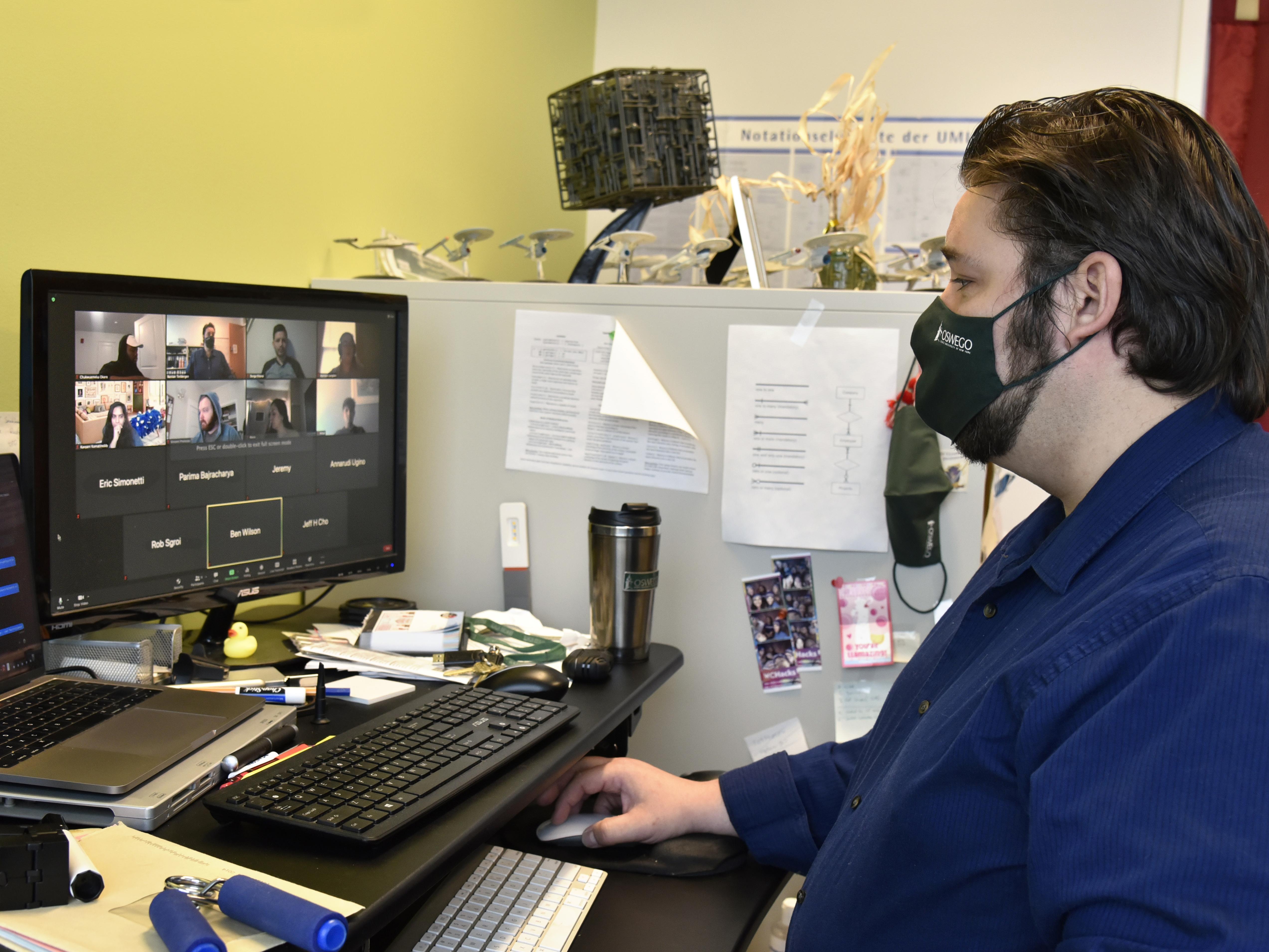Computer science faculty member Bastian Tenbergen with his “Software Design” engineering students.
For SUNY Oswego software engineering students, an ongoing collaboration with IBM and a successful alumnus has provided valuable experience within the professional realm of their prospective careers.
In 2019, SUNY Oswego computer science faculty member Bastian Tenbergen worked with alumnus and current IBM senior manager Paul Austin to design a new program within the school’s software design classes. “Software Design” (CSC 480) works to provide students with “development process management techniques” applicable at a professional level.
The class typically centers around a semester-long project, which students collaborate on. After Tenbergen spoke with Austin, they decided that IBM would act as a client for the students within the class.
For Austin, the decision to collaborate with his alma mater was easy.
“I like giving back to Oswego,” said Austin, a 1989 writing arts major whose journey took him initially into technical writing. “I also like helping people through the problems that I had to go through before… This is one way for me to share what I’ve learned with people that I care for, who are Oswego students.”
Austin described working with the students as “a blast,” saying that they were eager to learn and adapt to the new program.
“Oswego has a wonderful program in software engineering,” said Austin, adding the students “demonstrate a lot of innovative spirit.”
For the project, students work in teams, where they each tackle individual parts of the program. This requires intensive collaboration and teamwork within the class.
Austin said it is “really wonderful” to watch the students grow across the semester, beginning with no knowledge of the product and finishing with a fully functional program.
Team environment
“We really get practice with working in a team environment,” said Annarudi Ugino, a senior computer science major currently enrolled in the class. “I’m on a technical team, but we interact with more designed-focused teams and testing teams… We’re all kind of helping each other and getting the information from each team to get the product completed to the stakeholder’s satisfaction.”
“Having IBM in the spotlight was great,” said Leandro Garrido, a SUNY Oswego master in human-computer interaction graduate who participated in the project last semester. “They gave us resources, they gave us tips, specific courses, and it was very nice.”
Tenbergen stressed that the course focuses on how companies will develop software, and not simply “what the academic idea of software development is.”
“We do so much to make sure that what we teach is accurate to how companies operate,” said Tenbergen.
The opportunity to work with a company like IBM ensures that students understand how companies in the industry operate.
“It’s been really great to kind of model what a real work scenario would be like,” said Ugino. “It’s nice to have practice with the dialogue that you would normally have with a client.”
“When you are in college, you’re so busy doing homework, sometimes you don’t get to feel and work in an environment that kind of replicates what the industry does,” said Garrido. “But with IBM, we had that chance.”
Professional environment
Tenbergen said that one of the biggest factors is students being held accountable in the same manner as in a professional setting.
“We’re holding them accountable, towards real stakeholders with actual stakes in the project,” added Tenbergen.
The initial collaboration between IBM and CSC 480 students took place during the fall 2019 semester. As the program has progressed, both sides have been able to work out some kinks to allow the process to run more smoothly for everyone.
“The first time we went through it, it was a little difficult,” admitted Austin. “We worked with two teams in one class, and we kind of threw a lot at them to begin with.”
Part of the changes included assigning students a predetermined project, instead of tasking them with developing their own idea. They also refined their teaching process to the students to ensure they had a full understanding of the task at hand.
Austin has worked at IBM since fall 1989, just after graduating from Oswego. Although much has changed since his time on campus, he says that the school provided him with valuable career lessons that he still utilizes today.
“One of the things that comes back to me is: know your audience,” said Austin. “You have to consider your audience, and make sure that you tailor your deliverables.”
Tenbergen stated that overall, this experience allows students to easily prepare for professional life after graduation.
“Most students that have an opportunity to work in a context like this, they seamlessly transition to a company experience,” he said. “They have to learn very little about how a company works.”
The students feel this way as well.
The CSC 480 class “helped me a lot,” Garrido said. “Being able to work with people from the industry that are doing things like this on a daily basis, that are building products, I think it prepared me a lot.”
Garrido added, “I think the most important thing for me, in terms of preparation, was being able to communicate what I was doing, and what I did, in a professional way.”
This certainly proved beneficial in Garrido’s case. Currently, he works as an experience designer for Electronic Arts. Ugino, who is in her final semester at Oswego, echoed a similar sentiment.
“I think it has been one of the most helpful classes I’ve taken in my entire college career,” Ugino said. “Getting the teamwork experience in my field of study, and future field of work, has been invaluable.”
-- Story by Dylan McGlynn of the Class of 2021




